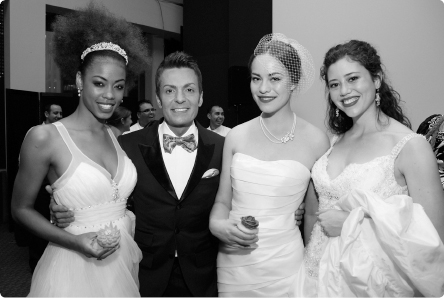Communicating through Physical Appearance

On Say Yes to the Dress, a bride’s dress choice is not merely a fashion statement, but a statement about who she is as a person. Similarly, your daily physical appearance is a form of nonverbal communication that expresses how you want others to see you.
Photo by Amy Sussman/Getty Images for Discovery Communications
On the hit TLC show Say Yes to the Dress, Randy Fenoli and other sales associates at Kleinfeld Bridal in New York City help prospective brides find the ideal wedding dress. The show involves finding the dress that fits a bride’s ideal image for how she should look. However, the show is not just about superficial allure. Instead, the choice of dress and accessories conveys a powerful communicative message to others about the bride’s self-identity.
Although weddings are an extreme example in terms of the emphasis placed on how we look, our physical appearance—visible attributes such as hair, clothing, body type, and other physical features—profoundly influences all of our interpersonal encounters. In simple terms, how you look conveys as much about you as what you say. And beauty counts. Across cultures, people credit individuals they find physically attractive with higher levels of intelligence, persuasiveness, poise, sociability, warmth, power, and employment success than they credit to unattractive individuals (Hatfield & Sprecher, 1986).
This effect holds in online environments as well. For example, the physical attractiveness of friends who post their photos on your Facebook page has noteworthy effects on people’s perceptions of your attractiveness (Walther, Van Der Heide, Kim, Westerman, & Tong, 2008). That is, if you have attractive friends’ photos on your page, people will perceive you as more physically and socially attractive; if you have unattractive friends, you’ll seem less attractive to others.
Your clothing also has a profound impact on others’ perceptions of you. More than 40 years of research suggests that clothing strongly influences people’s judgments about profession, level of education, socioeconomic status, and even personality and personal values (Burgoon et al., 1996). The effect that clothing has on perception makes it essential that you consider the appropriateness of your dress, the context for which you are dressing, and the image of self you wish to nonverbally communicate. When I worked for a Seattle trucking company, I was expected to wear clothes that could withstand rough treatment. On my first day, I “dressed to impress” and was teased by coworkers and management for dressing as if I was an executive at a large corporation. But expectations like this can change in other situations. During job interviews, for example, dress as nicely as you can. Being even moderately formally dressed is one of the strongest predictors of whether an interviewer will perceive you as socially skilled and highly motivated (Gifford, Ng, & Wilkinson, 1985).
Self-Reflection
Consider your physical appearance, as shown in photos on your Facebook page or other personal Web sites. What do your face, hair, clothing, and body communicate to others about who you are and what you’re like? Now examine friends’ photos on your pages. How might their appearances affect others’ perceptions of you?
Question
Self-Reflection